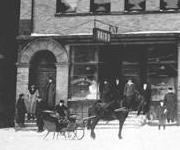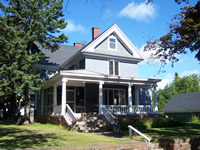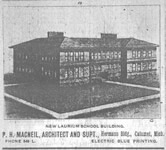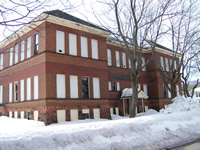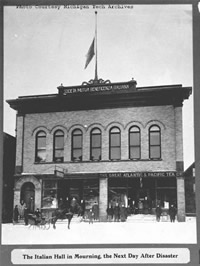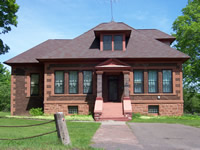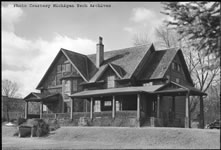Jones House Richard D. Jones, a dentist, had an office in the Herman Building in Calumet, where Paul Macneil also had offices. Apparently, he looked down the hall and hired an architect to design his house. The wood-frame building has a cross-gable roof. The walls of the first floor are sided in clapboard, the upper floors in shingles. An L-shaped porch with Corinthian columns and turned balusters is now partially glassed in. A large bay window has been added near the front, overshadowing the two smaller bay windows that originally graced the house. The architectural drawings indicate half timbering with pebble-dash cement in the front gable. The first floor had a living room, dining room, and den, along with a vestibule and reception hall. The bay windows were in the stairway and in the dining room. The second floor had three bedrooms and a bathroom.7
First Baptist Church The First Baptist congregation, which formed in 1895, built this church on land leased from Calumet & Hecla. The congregation hired architect Paul Macneil in 1907 and dedicated the church in June 1908. Construction cost a little more than $12,000.8 The handsome brick church has a prominent cross-gable roof with arched recesses in the wood-shingled gables. Jacobsville sandstone trims the walls and forms the prominent foundation. Windows and doors have Gothic arches. Four Corinthian columns and a modillioned cornice adorn the portico. Attached to the rear of the church are two additions. In 1968 the congregation added a 40' x 40' building for a Sunday school. In 1994 a 64' x 84' multipurpose facility was added. Briggs School The end bays of this large two-story building are pulled forward, giving added presence to this hip-roofed school building. Set on a high sandstone foundation, the building has brick walls in two contrasting colors, as well as sandstone beltcourses at the level of the sills. Most of the walls are windows, though, as every effort was made to bring natural light into the classrooms. Paul Macneil advertised this building as his work in the summer of 1906. The 10-classroom school was the largest of the schools in Laurium, a community that was growing rapidly. The school was named for Charles Briggs, who was on the Calumet Board of Education for thirty years, 1878-1909. He was also president of the Merchants and Miners Bank for 49 years and was president of the Calumet & Arizona Mining Company for 20 years.
St. Joseph’s Catholic Church Interior The Slovenian congregation of St. Joseph’s hired Paul Macneil to design the interior of its new structure. Construction had begun on the church in 1903 to the designs of Shand & Eastman, but that firm was no longer functioning by the time the congregation was ready to furnish the interior. A newspaper article written at the time of the dedication described Macneil’s work: “Upon entering the church one is immediately impressed with the perfect blending of the color scheme, from the wainscot to the cove of the vaulted arches and to the top of the high arched ceiling. The ceilings and walls are mainly panel work with emblematical center pieces in each panel, the color scheme is principally dark reds, blues and ivory. All coves and angles are richly decorated with massive stucco cornices, colored in ivory and embellished with gold leaf, the main cornice at the spring or foot of the arched ceiling conceal rows of many incandescent lights which at night illuminate the ceiling, while the lights themselves are invisible to the congregation. The large sanctuary arch as well as the side altar arches are similarly illuminated from cornice lights and these with the many small lamps of various colors which adorn the altars form a beautiful light effect.”9 The newspaper also praised the acoustics of the building. A painting of the Last Judgment above the main altar and paintings of angels above the side altars also ornamented the interior. An organ in the balcony and stained-glass windows were in place when the building was dedicated on June 28, 1908.10
Italian Hall The Italian Hall was a two-story building constructed for the Italian Benevolent Society. The first floor had two businesses: Vairo’s saloon and the Great Atlantic & Pacific Tea Co. The second floor had a large meeting hall. The Italian Renaissance Revival-style brick building was distinguished by a row of round-arched windows across the façade. The prominent cornice bore the name of the society that owned the building. The first floor had two store fronts and, on the far left, a sandstone arched entrance leading to the stairway to the second floor. In 1913, a tragedy occurred at the Italian Hall. During the strike, the union miners and their families were having a Christmas party at the hall when someone yelled, “fire.” In the rush to get out of the building, there was a pile-up in the stairway. Seventy-three people, most of them children, died in this bottleneck. There was no fire, and unionists claimed that the panic had been caused deliberately by company supporters, but nothing was proved. This tragedy was the single greatest loss of life in the Copper Country and gained nationwide fame as an incident emblematic of labor strife in the early 20th century. Despite this history, the building deteriorated and was demolished in 1984. The doorway behind which so many died was saved, though, and re-erected in a park on the site of the building as a memorial to those who lost their lives.11
Ahmeek Mine Office Calumet & Hecla Mining Company began to develop the Ahmeek Mine in 1907 and commissioned this building from Paul Macneil the following year. The office is located between the residential area in Ahmeek Location and the mine shaft. The brick building with sandstone trim is the only masonry building in the area. It is one-and-a-half stories tall with a hipped roof and hipped dormers. There is a small entrance portico. Windows in the front of the building are tripled. On the left side, interrupting the symmetry of the building, is a wing containing the pay window and vault. In the right front corner of the building was the superintendent’s office. Diagonally opposite was the chief clerk’s office, with a glass partition so that he could oversee the counting room in the left front.12 Worcester House The village of Chassell formed around the mill of the Sturgeon River Lumber Company beginning in 1887. In 1902 Charles Henry Worcester of Chicago bought the company for $65,000 and organized the Worcester Lumber Company the next year. At Chassell, Worcester employed 120 men at the mill, 30 on its dedicated railroad, and another 300-400 in four camps.13 The company thrived and so did Worcester, who acquired the C. V. McMillan Company in Ontonagon in 1908 and formed the Greenwood Lumber Company.14 In 1908, president C. H. Worcester announced that he would make Chassell his summer home and commissioned Paul Macneil to design a house. Macneil designed a two-story wood-frame house that measured 35’ x 60’, calling it a “typical old English country house.” The 20’ x 35’ living room was the featured space, with a large fireplace flanked by “two large high-backed old-fashioned seats, of the Mission-style, built into the wall.” All of the rooms had beamed ceilings and were decorated in the Mission style. Besides the large living room, the house had a smaller living room, two reception halls, a dining room, kitchen, and pantries, with three large bedrooms on the second floor. The house was wired for electricity and furnished with steam heat. The newspaper mentioned plans for a columned pergola measuring 40’ x 14’, although it is not certain if this was ever built.15 Photographs show a wide porch across the front and a porte cochere. The Worcester Lumber Company went out of business in 1928, although Worcester and his wife, the former Mary Southwell, continued to return to his house in Chassell every summer until shortly before his death in 1956.16 In 1957 the Sigma Rho fraternity of Michigan Tech acquired the building and occupied it until a spectacular fire destroyed it in 1974. The fraternity built a new house on the site.
|
